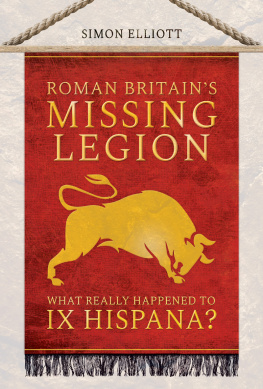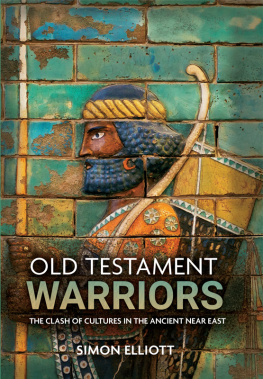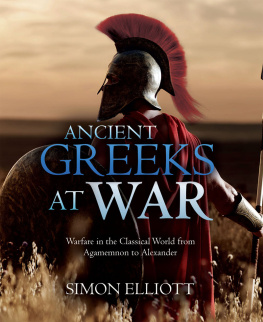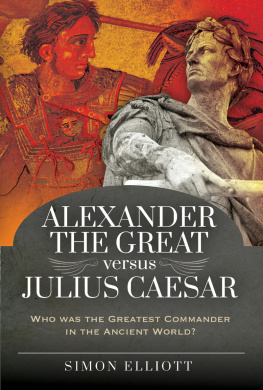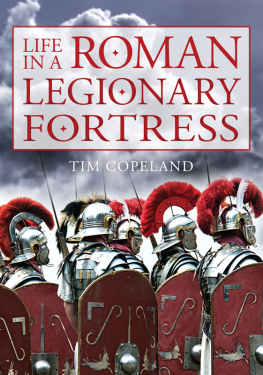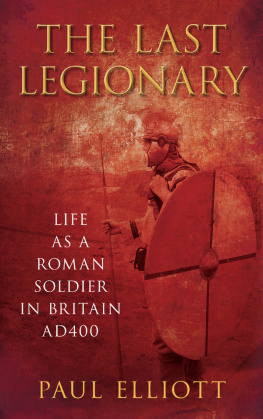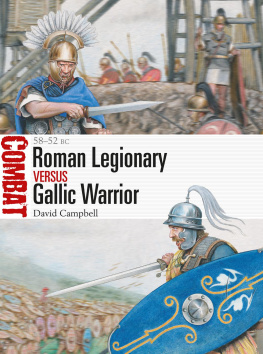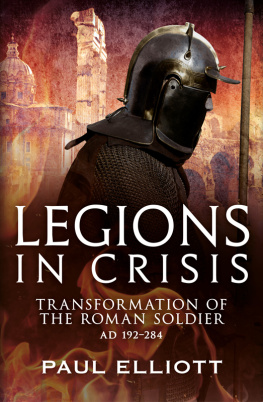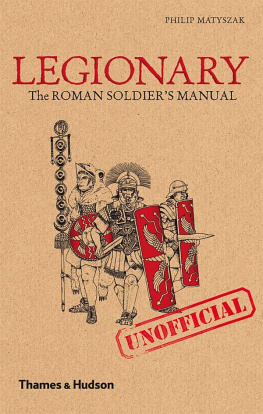Published in Great Britain and
the United States of America in 2018 by
CASEMATE PUBLISHERS
The Old Music Hall, 106108 Cowley Road, Oxford OX4 1JE, UK
1950 Lawrence Road, Havertown, PA 19083, USA
Casemate Publishers 2018
Paperback Edition: ISBN 978-1-61200-611-6
Digital Edition: ISBN 978-1-61200-612-3 (epub)
Kindle Edition: ISBN 978-1-61200-612-3 (mobi)
All rights reserved. No part of this book may be reproduced or transmitted in any form or by any means, electronic or mechanical including photocopying, recording or by any information storage and retrieval system, without permission from the publisher in writing.
A CIP record for this book is available from the British Library
For a complete list of Casemate titles, please contact:
CASEMATE PUBLISHERS (UK)
Telephone (01865) 241249
Email:
www.casematepublishers.co.uk
CASEMATE PUBLISHERS (US)
Telephone (610) 853-9131
Fax (610) 853-9146
Email:
www.casematepublishers.com
INTRODUCTION
The Roman legionary was the elite fighting soldier of the ancient world. Clad in helmet and banded iron armour, and carrying rectangular body shield, lead-weighted javelins and vicious stabbing sword, his image has come to symbolise the might of the Roman Empire.
The story of how this warrior rose to the pinnacle of martial prowess is a more complex one than commonly thought. To a large extent it reflects the Roman trait for the successful assimilation of their opponents best military ideas, a thread examined in detail in this work. This, together with Roman societys unusual propensity for grit with its seeming inability to accept defeat in any form, meant that those who stood toe-to-toe on the battlefield with the Roman legionary were brave indeed, or foolish.
Much has been written about the Roman legionary, and this book both builds on that canon of work but also brings my own new primary research about the Roman military to the fore. In so doing it tells the legionarys story for a new generation, one perhaps keener than ever to understand the wider experience of life as a Roman warrior on the frontiers of this most imperial of empires as it waxed inexorably, and then waned dramatically. In that context it shows how the Roman legionary and his role in battle changed from one always on the front foot, driving the borders of the empire forward with unstoppable legionary spearheads, to one acting as the bulwark on the Roman limes as offence turned to defence, the empires enemies now crashing upon her borders.
To tell this dramatic story the book is broken down into five chapters (and a conclusion), each sequentially building the readers knowledge of every aspect of the Roman legionarys life. This introduction sets the scene for the book. provides a brief narrative on the history of the mid-later Roman Republic and then the Principate and Dominate phases of the empire, to allow the reader to see how the legionary sat within the wider context of Roman society and history. The next three chapters form the core of the book, covering the history of the Roman legionary and detailing his equipment, then the legionary on campaign and in battle, and finally the legionary in his many non-conflict related roles. The latter reflects the numerous specialists within the legions of Rome over and above the fighting troops, which allowed the Roman state to deploy the military for a wide variety of tasks additional to their more obvious role as the cutting edge of Roman military power. The main focus here is the Principate legionary of the 2nd and early 3rd centuries AD when the empire was at its height. Next, I briefly look at other Roman troop types which, together with the legionary, made up the overall Roman military complement. This peaked at around 450,000 as the reign of Septimius Severus came to an end in AD 211 (in 33 legions and around 400 auxiliary units). In the same chapter I also consider the later Roman army of the Dominate to show how the role of the legionary changed as the military evolved to face rapidly evolving threats from both without and within. Finally the book ends with my conclusion, considering the legacy of the Roman legionary in terms of military tradition, and also our wider appreciation of the Roman Republic and Empire.

A legionary was the elite fighting soldier of the midlate Roman Republic, the Principate Empire, and at least the early part of the Dominate Empire. An auxiliary was a lesser though still professional fighting soldier of the Principate and Dominate Empires. Naval milites (a generic name for soldier) refers to all nautical troops in the fleets of Rome, whether marines, sailors or rowers.
When using classical and modern names, I have attempted to ensure the research presented on the legionary and the Roman military more broadly is as accessible as possible to the reader. For example, I use the modern name where a place is mentioned, referencing its Roman name (if appropriate) at that first point of usage. Meanwhile, when a classical name for a role or position is well understood such as legate , I use that (referencing the modern name at the first use, in this case general).
The size-based hierarchy for permanent fortifications now utilised by those studying the armed forces of Rome to describe their size describes:
Fortress, a permanent base for one or more legions. Some were 20 hectares or more in size, a significant engineering undertaking for the legionaries and other military units of Rome.
Vexillation fortress, a large fort of between eight and 12 hectares. Such fortifications held a mixed force of legionary cohorts and auxiliaries.
Fort, a garrison outpost occupied by an auxiliary unit or units. These were between one and six hectares in size.
Fortlet, a small garrison outpost large enough to hold only part of an auxiliary unit.
Temporary fortifications in the form of marching camps, built by a Roman military force at the end of every days march in enemy territory, were also a key feature of the professional life of the legionary.


